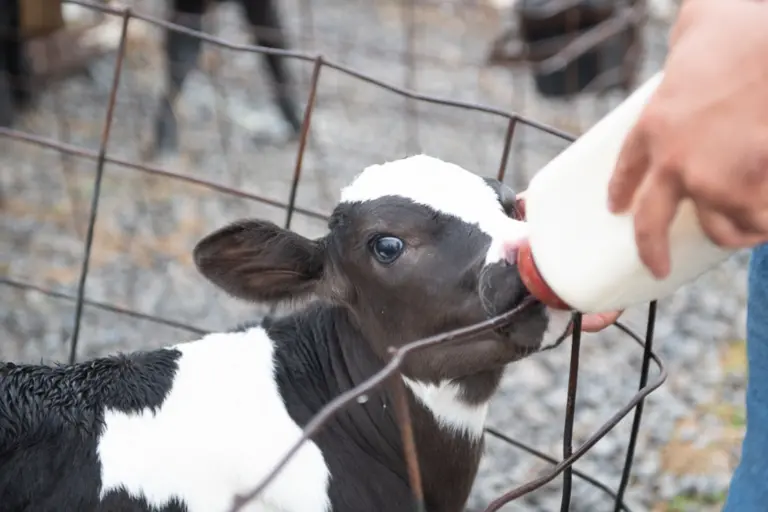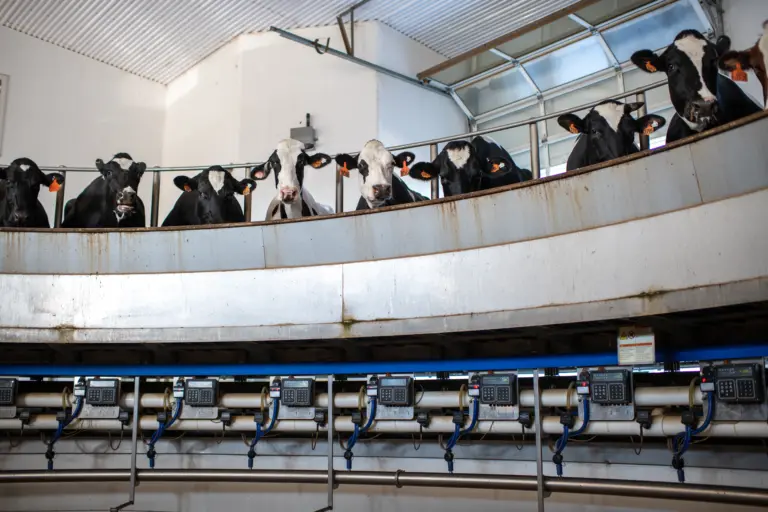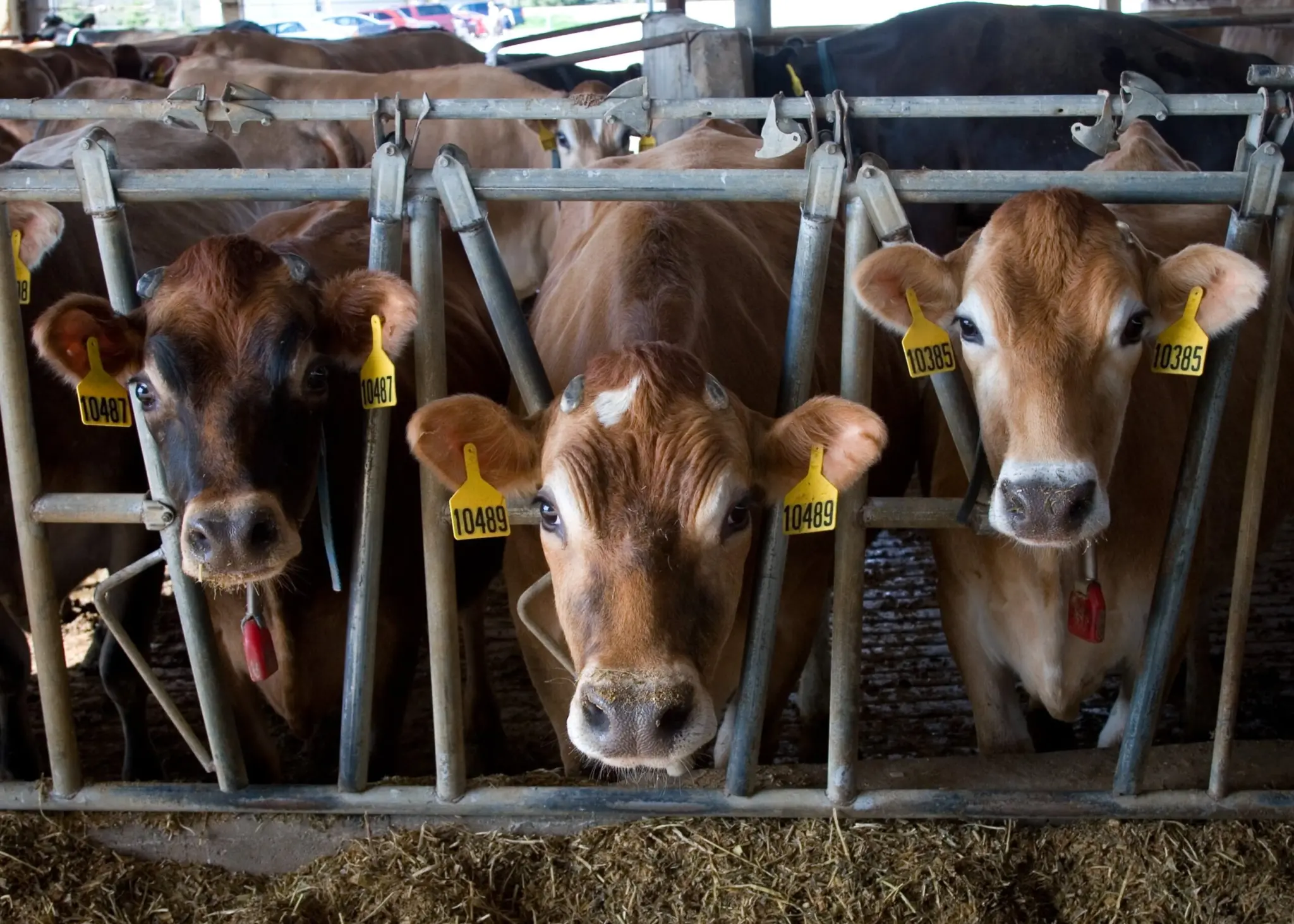
Dairy Cow Facts
A cow that is producing milk eats about 100 pounds each day of feed, which is a combination of hay, grain, silage, and proteins (such as soybean meal), plus vitamins and minerals. Cows are the ultimate up-cyclers and can eat things humans can’t, including fuzzy cotton seed, spent brewer grains, and more. Farmers employ professional animal nutritionists to develop scientifically formulated, balanced and nutritious diets for their cows. Cows also need fresh, clean water.
Cows need multiple stomachs to break down grasses and roughage. The cow has 4 stomachs to digest these grasses properly. These stomachs include the rumen, reticulum, omasum, and abomasum. This unique digestive system makes cows the ultimate recyclers. They can convert plants that humans cannot eat into nutritious foods like milk.
Males are called bulls. Females, before giving birth, are called calves or heifers. After they give birth, female dairy animals are called cows.
Dairy cows usually weigh over half a ton and the average weight for dairy cows varies by breed. The average weight for Ayrshire cattle is 990-2,000 pounds. The average weight for Brown Swiss cows is 1,300-1,400 pounds. The average weight for Guernsey cattle is around 1,000-1,500 pounds. The average weight for Holstein cattle is around 1,500 pounds. Jersey cows can range in weight from 770-1,500 pounds. Milking Shorthorn cows typically weigh between 1,400-1,500 pounds. The average Red & White dairy cattle weigh around 1,400 pounds.
Dairy cows that produce milk need a higher amount of water per day than other types of cows. When a dairy cow is producing milk, it can consume anywhere between 30 and 50 gallons of water each day.
The amount of manure produced can depend on the weight, diet, and breed of dairy cow. However, the average amount of manure produced by a dairy cow is around 82 pounds of manure per day per 1,000 pounds each cow weighs.
Cows rest about 12-14 hours per day.
Most cows will eat 100 pounds of the total mixed ration (TMR) every day.
Dairy cows can live up to 20 years.
The female calves of dairy cows may be raised to produce milk. Male calves are sold for beef production.
Depending on the breed of the dairy cow, dairy calves weigh 55-95 pounds at birth.

Milking
Dairy cows love routine and are most comfortable with consistency. They will know where to go by doing the same thing around the same time every day.
Most dairy cows are milked two to three times per day. On average, a cow will produce six to seven gallons of milk each day.
Early lactation cows are cows that are within the first 100 days of lactating. These cows produce less milk overall than late lactation cows. Milk production for a cow in the early lactation phase is about 3 to 6 gallons of milk per day. Late lactation cows are in about the last month of milk production, and milk production is about 25% of what it was during peak lactation.
The exact amount of dairy produced by a dairy farm varies greatly depending on the number of cows on that farm. However, the average dairy cow can produce between six to seven gallons of milk each day.
All cows produce milk once they deliver a calf. About 12 to 14 months after the birth of her previous calf, a cow will calve again, thus providing milk.
A cow’s period of lactation after giving birth is usually around 9-11 months. This can vary slightly depending on several factors such as age, diet, and breed.
Dairy cows can be milked anywhere from 2-3 times daily.
Cows can drink between 30-50 gallons of water per day if they are actively producing milk. Another 7 gallons of water per cow (on average) is used for cleaning. This means that dairy farms use around 37-57 gallons of water per cow daily.
Did you know milk is super local? Most people live within 100 miles of a dairy farm, and fluid milk typically travels from the farm to your local store in as little as 48 hours.
Dairy Cow Care
Dairy farmers take great care of their animals by providing a nutritious diet, good medical care, and healthy living conditions. Dairy farmers work closely with veterinarians, animal nutritionists and other professionals to keep their cows healthy and comfortable. Dairy farmers’ commitment to ensuring high-quality milk begins with taking good care of their cows and treating them with respect.
Yes! Dairy farmers are dedicated to producing high-quality milk, and that begins with taking good care of their cows. Dairy farmers work closely with veterinarians and professional animal nutritionists to keep their cows healthy and well-nourished. Nutritious diets, healthy living conditions and good veterinary care are all essential when it comes to producing safe, wholesome, nutritious milk.
Cows are only treated with antibiotics when necessary. When illness requires that a cow be treated, antibiotics are administered according to strict FDA guidelines, which include withholding milk from sale. When a cow’s milk is withheld, she is given special care and attention separate from the rest of the milking herd until her milk tests free of antibiotics.
Many factors affect the type of environment available to dairy cows. Access to pasture is determined mainly by geography, availability of land suitable for grazing, and weather conditions. In all cases, the well-being, protection and comfort of their cows are dairy farmers’ top priorities. Many of today’s dairy farms use free-stall housing, a type of barn that allows cows the freedom to move around at will and eat and sleep whenever and wherever they choose. In this type of barn, feed for the animals is available in a feed alley (a clean, impervious surface), which cows can access 24 hours a day. In addition, the barns are designed to provide sunshine and fresh air.
Cows housed indoors may sleep on sand beds or mattresses made of rubber, foam or a combination of materials. Most dairy barns also use advanced ventilation systems to ensure air quality. On warm days, farmers use fans and misters to keep cows cool and comfortable.
